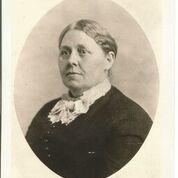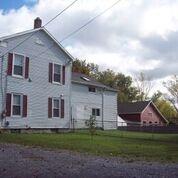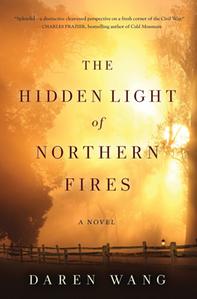
|
|
| photo: Tom Meyer | |
On August 29, St. Martin's Press will publish The Hidden Light of Northern Fires, the debut historical novel from Daren Wang, a founder and the executive director of the AJC Decatur Book Festival. Set in Town Line, N.Y., Hidden Light is based on historical figure Mary Willis, an outspoken abolitionist who lived in a small Northern town close to the Canadian border that voted to secede from the Union in 1861. Mary has turned her family's farm into a stop on the Underground Railroad, and after an escaped slave named Joe Bell collapses in her father's barn, Mary decides to risk everything to help Joe Bell get to Canada.
To write The Hidden Light of Northern Fires, Wang drew on pieces of overlooked history surprisingly linked with his own life. The project began about 10 years ago, when he first started researching his childhood home of Town Line.
"On a lark, I did a google search of my old street address," recalled Wang, whose family lived on a property in Town Line that contained a renovated barn and a main house with some unusual features, including the remains of a tunnel in the basement and a large brass bell hanging in the attic. What turned up in that google search was an oral history written by a member of the Willis family telling the stories of Mary Willis and a brother who joined the Union Army during the Civil War. Wang said he was stunned to find out that the renovated barn in which he had lived as a child had once been a stop on the Underground Railroad.
"Growing up there I had never heard the name Willis," said Wang. "I never knew any of that when I was there."

|
|
| Mary Willis Webster | |
For the next few years, researching Town Line's history and the history of the Willis family became a hobby bordering on a "bizarre obsession" for Wang. He learned that Mary Willis's father Nathan Willis had in fact founded Town Line, that Mary turned her family's farm into an Underground Railroad station after returning home from studying at Alfred University, and, incredibly, that after voting to leave the Union in 1861, Town Line did not officially rejoin it until 1946. Along the way he found a host of fascinating historical sources, including tax records from the 1850s detailing exactly what was being raised and grown on the Willis farm, a train schedule indicating that Abraham Lincoln's funeral train passed through Town Line, and "thousands of years worth of Indian artifacts" dug up around Town Line over the years.
"I was also kind of exploring the greater history of western New York, which is largely ignored but really fascinating," he remarked. "I just became really enraptured in the history of this place I grew up in, which I thought was the most boring place in the world while I grew up there."
At first, the idea of writing a book was "far too intimidating" for Wang to seriously consider, though he continued to collect information. He recounted how he would go out drinking with various writer friends during that span and try to convince them that they should write the book. His pitches were never quite successful, however, and after about three years of research Wang resolved to write it himself.

|
|
| The Willis House and Barn | |
"I settled down and said, somebody's got to do this," Wang explained. Although he had never considered himself to be a writer, he felt he had to do it, not just because he had done so much research but because "nobody knows the landscape and the place like I do."
Writing The Hidden Light of Northern Fires took Wang around seven years. He said that he often aspired to the kind of language used by Charles Frazier, a friend of his, in his Civil War novel Cold Mountain, adding that he in fact wrote about 300-400 words of Hidden Light on the same desk on which Frazier wrote Cold Mountain. Wang also noted that though he grew up in the North, about 15 minutes from Canada, he's been "pretty steeped in Southern writers for thirty years now."
"They're talking about me as a Southern writer. Most of my tour is in the South," mused Wang. "I guess that in the end, the idea of landscape and how that works and plays [in the novel] feels more Southern than Northern."
 To promote and celebrate the launch of The Hidden Light of Northern Fires, Wang is going on an ambitious and unusual book tour. Between his work with the Decatur Book Festival and an earlier career in public radio, he has met and befriended many authors over the years. Wang thought of the book tour as a chance to hit the road and reconnect with old friends. He had the idea, inspired in part by Jim Atkinson's travelogue and bar guide The View from Nowhere, to embark on a bourbon tour. At each stop he will meet up with a local author or two to experience both their favorite local watering hole and favorite bourbon cocktail, and Wang will blog about his quest for the perfect bourbon cocktail on the website The Bitter Southerner. The focus on bourbon cocktails, he explained, comes from the fact that through cocktails, as opposed to straight bourbon, one can get a much stronger idea of personality and a greater sense of place.
To promote and celebrate the launch of The Hidden Light of Northern Fires, Wang is going on an ambitious and unusual book tour. Between his work with the Decatur Book Festival and an earlier career in public radio, he has met and befriended many authors over the years. Wang thought of the book tour as a chance to hit the road and reconnect with old friends. He had the idea, inspired in part by Jim Atkinson's travelogue and bar guide The View from Nowhere, to embark on a bourbon tour. At each stop he will meet up with a local author or two to experience both their favorite local watering hole and favorite bourbon cocktail, and Wang will blog about his quest for the perfect bourbon cocktail on the website The Bitter Southerner. The focus on bourbon cocktails, he explained, comes from the fact that through cocktails, as opposed to straight bourbon, one can get a much stronger idea of personality and a greater sense of place.
All told, Wang will make more than 50 stops on the Hidden Light tour, with more than 30 of them at bookstores. Given his background of working with bookstores and authors, St. Martin's Press let him handle scheduling the tour. "They were expecting maybe five-to-ten dates," Wang said, laughing. --Alex Mutter

